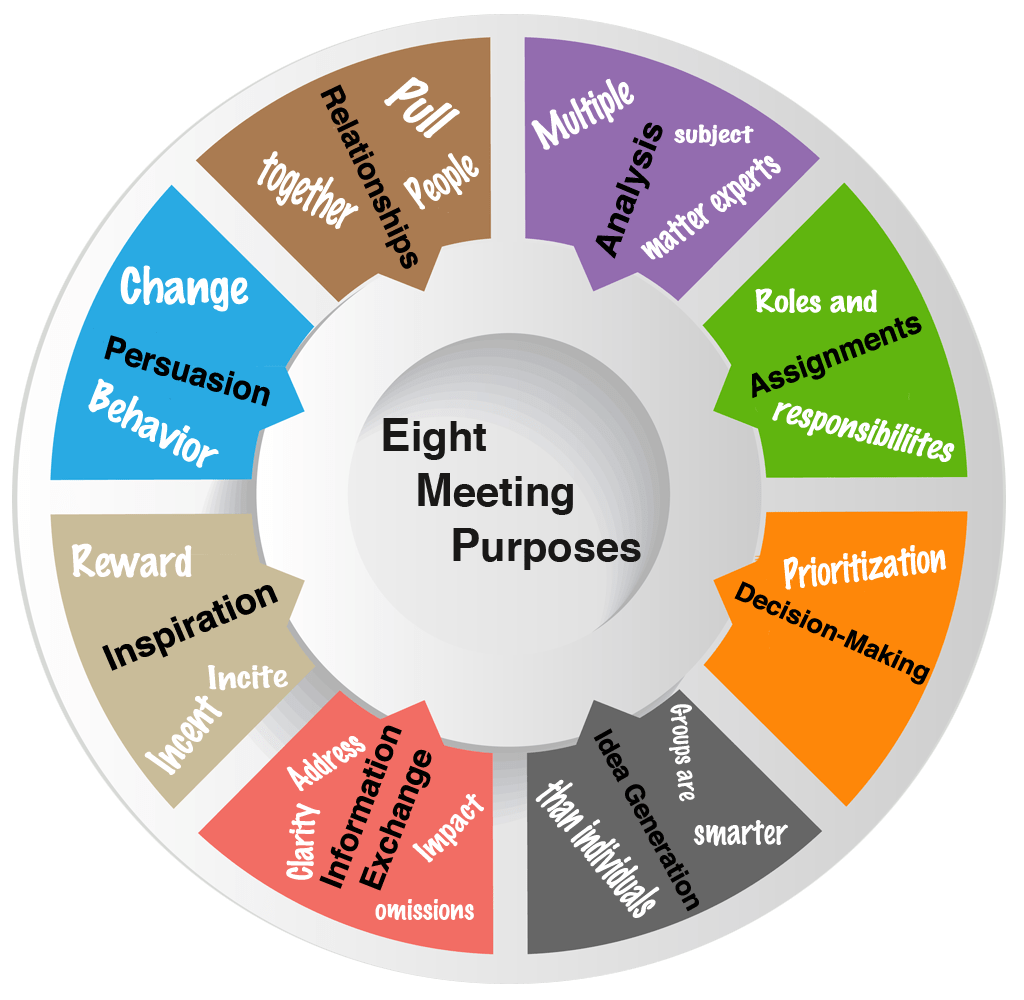Effective meetings are first based on a clear line of sight to an end result, preferably something that can be documented.
Yet, frequently meeting purposes rely on determining WHAT deliverable or result to create. Consequently, using meeting time to determine the meeting output indicates unclear thinking and weak meeting design. Avoid wasting time by knowing your purpose in advance. The eight most common meeting purposes and benefits and problems include the following.
Eight Meeting Purposes
Analysis
- Highly complex situations may require multiple subject matter experts. Frequently, experts have their own vocabulary and a meeting helps to clarify understanding and agreement about terms and definitions. Have you ever run a meeting with Ph.D. engineers and creative marketing folks together? As a result, sometimes it sounds like they are from different planets. Carefully document operational definitions that arise during analysis sessions. You may discover people violently agreeing with each other. Unfortunately, they use different words to describe the same thing or define the same thing differently.
Assignments
- Structured meetings or workshops provide an excellent means of building agreement around roles and responsibilities. Furthermore, when using a structured method, you can leave the meeting with a consensually built GANTT chart, estimation of resource requirements, and approximation of budget needs. Because “WHO Does WHAT by WHEN” captures the primary reason behind a planning session, focus on the actions first before you make the assignments.
Decision-Making
- Since resources typically fall short of the demands, prioritization remains critical for high-performance groups. As a result, no teams possess the time or resources to do everything. Consensual understanding around prioritization provides a compelling reason for hosting a meeting or workshop. Since items that need to be prioritized range from the simple to the complicated through the complex, identify the most appropriate tool for prioritizing, before the meeting starts. Then, prepare a backup approach as well.
Idea Generation
- Because groups create more options than simply aggregating the input of participants, groups are smarter than the smartest person in the group. Many of the best ideas did not walk into the meeting because they were created during the meeting, based on stimulation provided by the input from others. Use SCAMPER or Changing Perspectives to drive more ideas, thus increasing your likelihood for applied creativity, innovation, or breakthrough.
Information Exchange
- By far and away the most common reason for meetings may also be the worst possible reason for justifying a meeting. With instant access and electronic filing cabinets, coming together face-to-face is a very expensive way to exchange information (albeit potentially quicker and less costly when conducted online). A better justification would be to address questions about clarity, agreement, and omissions of information that has already been exchanged. Alternatively, use meeting time to explore the impact the information might have on the plans and behavior of meeting participants and related stakeholders.
Inspiration and Fun
- Use meetings to reward, incentivize, and incite because they can be effective at motivating others. They are usually hosted on a large scale and include complimentary events or sessions that may advance learning and improve teamwork. Therefore, anticipate using breakout sessions by creatively preparing activities appropriate for your participants and the situational constraints. The quality of group output increases tremendously when you contrast and compare input from different teams. Plus, with breakout sessions, you are giving quieter people permission to speak freely. Participants afraid of speaking up in a group are less reticent to make contributions to the conversations that occur with a few people in a breakout session.
Persuasion
- Persuading and convincing others to agree with your argument or decision represents the worst possible reason for holding a meeting. Consider the three primary forms of persuasion, namely: identification (e.g., advertising), internalization (i.e., long-lasting), and forced compliance (i.e., “gun to the head”). Because meetings display ineffectiveness using any of the three primary forms of persuasion, they rarely succeed at convincing others. In fact, they can backfire. When the leader appears to have already made up their mind, participants wonder why they had to waste their time in a meeting. If you have the answer, tell them, and do not conduct a meeting. Meetings represent a highly expensive forum for information-sharing.
Relationships
- Simply bringing together people face-to-face provides the glue that pulls people together and gets them to work more cooperatively. Frequently venting, or managing conflict, results in increased effectiveness. When people don’t agree with each other and need to reconcile their points of view invest in face-to-face meetings. Arguments are rarely settled by text messages and PDF documents. Many times, conflict and arguments also require a referee, the perfect time to engage a facilitator.
Five compelling reasons to host facilitated sessions
Why host facilitated sessions? Making choices represents the most important actions people take every day, to decide. Properly made decisions amplify productivity. Choose wisely when to work alone, speak with another person, or call for a team meeting. The advantages of a structured meeting or workshop include:
- Higher quality results: Groups of people make higher quality decisions than the smartest person in the group. Facilitated sessions encourage the exchange of different points of view. Structure enables groups to identify new options. In fact, any person or group with more options at its disposal makes higher-quality decisions.
- Faster results: Facilitated sessions accelerate the capture of information. Faster output results when meeting participants (aka subject matter experts) arrive prepared. Participants arrive with an understanding of the questions and issues at hand.
- Richer results: By pooling skills and resources, diverse and heterogeneous groups develop more specific details and anticipate future demands, subsequently saving time and money in the project or program life-cycle.
- People stimulate people: Properly facilitated sessions lead to innovation and the catalyst for innovative opportunities because many perspectives generate a richer (360-degree) understanding of a problem or challenge, rather than a narrow, myopic view.
- Transfer of ownership: Facilitated sessions motivate further action by creating deliverables that support follow-up efforts. Professional facilitators use a method that builds commitment and support from the participants, rather than directing responsibility at the participants.
To Host Facilitated Sessions
Conducting facilitated sessions includes preparatory time, actual contact time during the session, and follow-up time as well. Therefore, successful sessions depend upon clearly defined roles, especially distinguishing between the role of facilitator and the role of methodologist (that are also discrete from the role of scribe or documenter, coordinator, etc.). To ensure getting done faster, carefully managed sessions embrace ground rules.
Thorough preparation and advance effort before the session ensures higher productivity:
- Researching both meeting design options and content to be explored
- Review and documentation of minutes, records, findings, and group decisions that affect the project being supported with this particular meeting or workshop session
- Completion of individual and small group assignments prior to sessions
Incite Involvement, Incent Ownership
Professional and structured facilitation generates high involvement among all participants. Therefore, appropriate terms for describing them include workshops or workouts. Consequently, avoid an overly ambitious agenda and plan for at least two, ten-minute breaks every four hours. Use our MGRUSH ten-minute timers to ensure that breaks do not extend to eleven or twelve minutes. Strive to provide dedicated resources, such as a facilitator professionally trained in structured methods.
Discourage unplanned interruptions, especially with phones and laptops. “Topless” meetings are increasingly popular, meaning no laptops or devices (e.g., smartphones). Allow exceptions for accessing content needed during the session. “No praying underneath the table” is another rule used to discourage people from using gadgets on their laps, presumably beyond the line of sight of others. In fact, everyone can see what they are doing anyway. For serious consensual challenges or multiple-day sessions, conduct sessions away from the participants’ everyday work site to minimize interruptions and everyday job distractions.
Chief Collaboration Officers
Granted, much of the material above becomes the responsibility of the facilitator. But if they won’t do it, you better. Remember, collaborative work replaces thousands of dollars lost in poorly run meetings. Harvard Business Review (HBR) states further that collaboration answers many of the business challenges. HBR encourages leaders to promote collaborative work and teamwork, and suggest . . .
“. . . we believe that the time may have come for organizations to hire chief collaboration officers.”
______
Don’t ruin your career by hosting bad meetings. Sign up for a workshop or send this to someone who should. MGRUSH workshops focus on meeting design and practice. Each person practices tools, methods, and activities every day during the week. Therefore, while some call this immersion, we call it the road to building high-value facilitation skills.
Our workshops also provide a superb way to earn up to 40 SEUs from the Scrum Alliance, 40 CDUs from IIBA, 40 Continuous Learning Points (CLPs) based on Federal Acquisition Certification Continuous Professional Learning Requirements using Training and Education activities, 40 Professional Development Units (PDUs) from SAVE International, as well as 4.0 CEUs for other professions. (See workshop and Reference Manual descriptions for details.)
Want a free 10-minute break timer? Sign up for our once-monthly newsletter HERE and receive a timer along with four other of our favorite facilitation tools, free.

Terrence Metz, president of MG RUSH Facilitation Training, was just 22-years-old and working as a Sales Engineer at Honeywell when he recognized a widespread problem—most meetings were ineffective and poorly led, wasting both time and company resources. However, he also observed meetings that worked. What set them apart? A well-prepared leader who structured the session to ensure participants contributed meaningfully and achieved clear outcomes.
Throughout his career, Metz, who earned an MBA from Kellogg (Northwestern University) experienced and also trained in various facilitation techniques. In 2004, he purchased MG RUSH where he shifted his focus toward improving established meeting designs and building a curriculum that would teach others how to lead, facilitate, and structure meetings that drive results. His expertise in training world-class facilitators led to the 2020 publication of Meetings That Get Results: A Guide to Building Better Meetings, a comprehensive resource on effectively building consensus.
Grounded in the principle that “nobody is smarter than everybody,” the book details the why, what, and how of building consensus when making decisions, planning, and solving problems. Along with a Participant’s Guide and supplemental workshops, it supports learning from foundational awareness to professional certification.
Metz’s first book, Change or Die: A Business Process Improvement Manual, tackled the challenges of process optimization. His upcoming book, Catalyst: Facilitating Innovation, focuses on meetings and workshops that don’t simply end when time runs out but conclude with actionable next steps and clear assignments—ensuring progress beyond discussions and ideas.






Perfect post, much gratitude for this great information.!